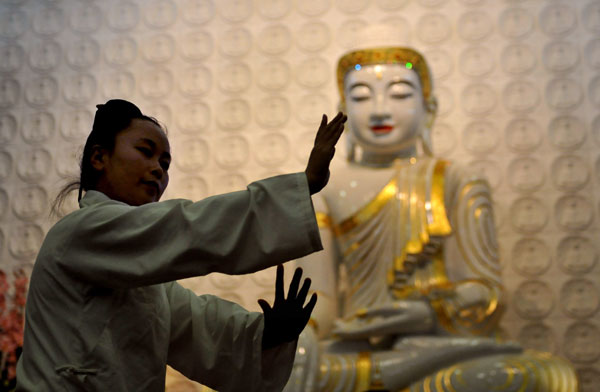 |
| A Taoist nun performs Taoist kung fu during a cultural exchange in Paris. Taoism is an ancient tradition of philosophy and religious beliefs based on Chinese customs that emphasize harmony between humanity and the natural world. CHEN XIAOWEI/XINHUA |
The number of ordinations conducted by the Celestial Master Sect of Taoism, in Longhu Mountain in Yingtan, has risen to about 300, from 184 in 2012, and 160 in 2010, according to the website of the Taoism sect. "The number of foreign disciples ordained has exceeded the number of Chinese ordained," said Zhang Yanhong, a practitioner at Longhu Mountain.
Huang Xinyang, vice-president of the China Taoist Association, said the association will continue with a program to push forward Taoism overseas, including visiting three to five countries each year to spread the Taoist classics and host demonstrations of qigong, the Taoist method of maintaining corporeal well being.
Last year, the association launched its maiden overseas cultural exchange in Europe to promote the Taoist culture, and Huang said it's also preparing to establish a global fellowship society to increase the number of exchanges between Taoists across the globe.
Journey to the East
Many Western practitioners were introduced to Taoism through its medical practices, and also by reading the TaoDe Ching, attributed to Lao Tze (571-471 BC), who is often described as the founding father.
However, according to Palmer, unlike Buddhism or Hinduism, there are no Taoist masters in the West. "There is nobody in the West who can teach you Taoism. You have the books, the art, music and philosophy. And really you then make it what you want," he said.
To further their knowledge, many practitioners travel to China, often visiting sacred mountains, to seek inspiration fromTaoist priests.
Herve Trestard, chairman of the Mexican Taoist Association, had studied traditional Taoist medicine and the sect's classic books before he decided to learn more about the religion itself. He traveled to China in 2007, and visited a number of temples in Beijing and provinces such as Henan, Shaanxi and Jiangxi in his search for a teacher. Eventually, he met a priest at the Qinghuagong Temple in Xi'an in Shaanxi who was willing to take him as a disciple.
"I received my Taoist name (Jingwei) and changed my faith to the Daoist religion. I returned in 2008 to live for a month in the temple, where I was ordained in the Longmen branch of Quanzhen Taoism," he said.
"I think we have to share the experiences of Chinese priests, because in the West we only have Daoist theories and translated books. It's very important to live in the temple so we can understand the reality of the priests' lives, "he said.
Recalling his arrival in China in 2004, Shannon described how he marveled at the examples of calligraphy he was given as a gift at a temple on Qingcheng Mountain in Sichuan province. He said he always explains the calligraphy to his students in their first lesson as a reminder of the importance of sticking to Taoist traditions.
